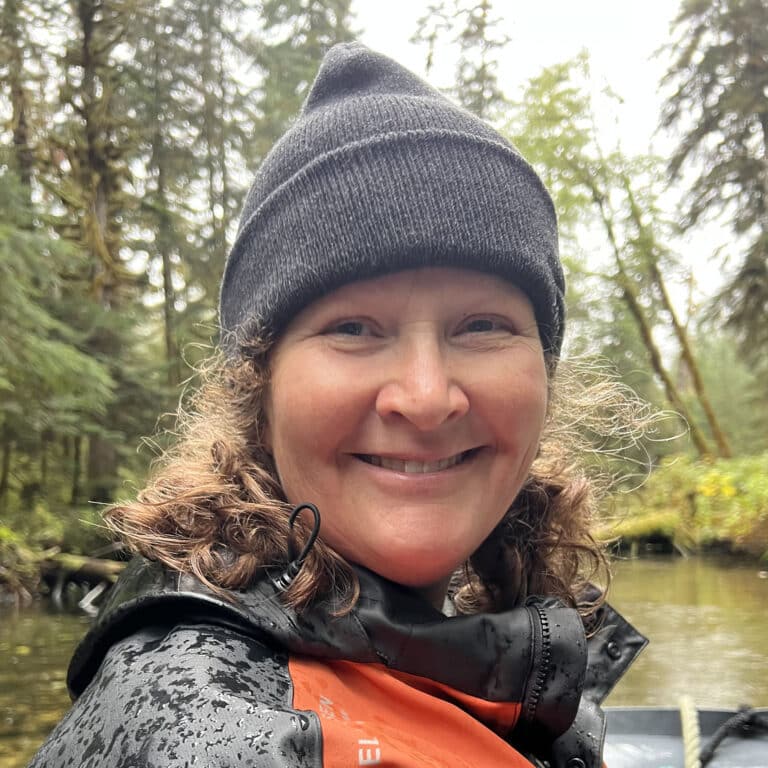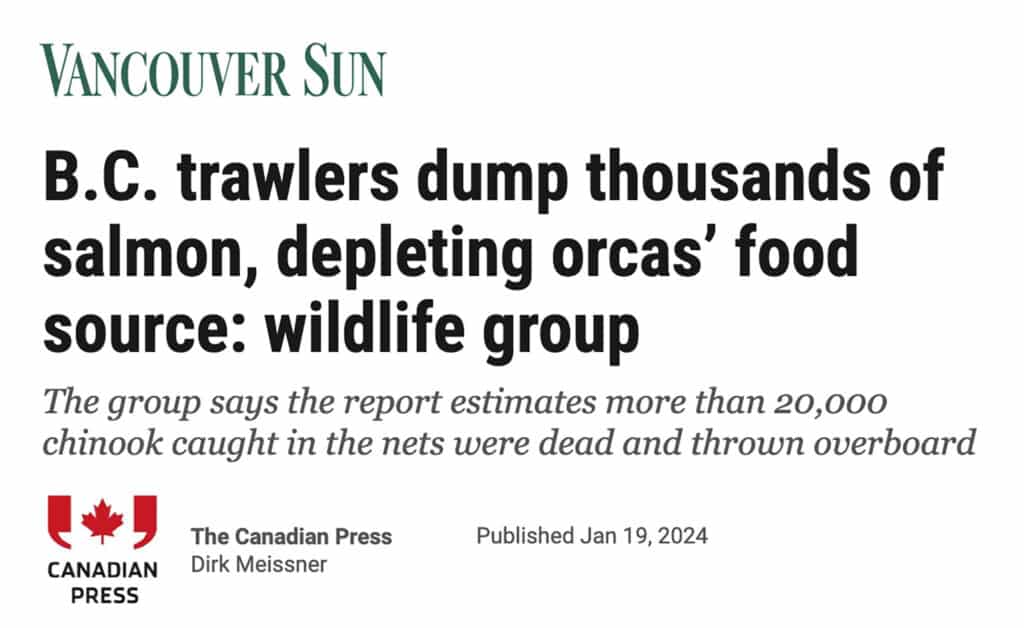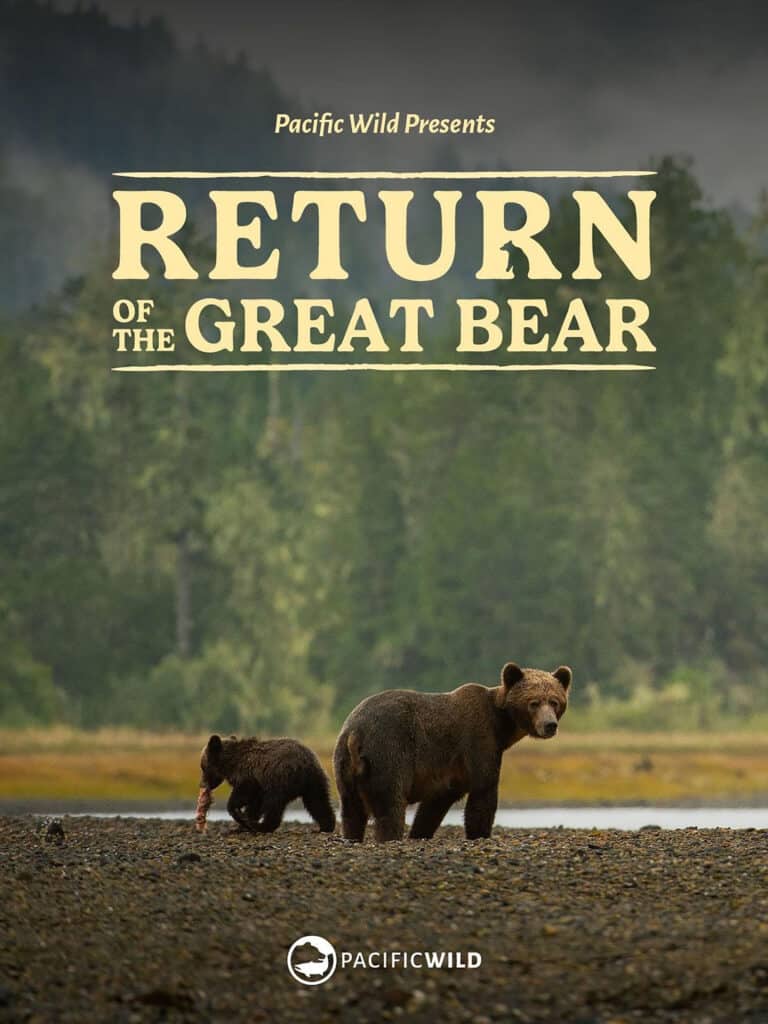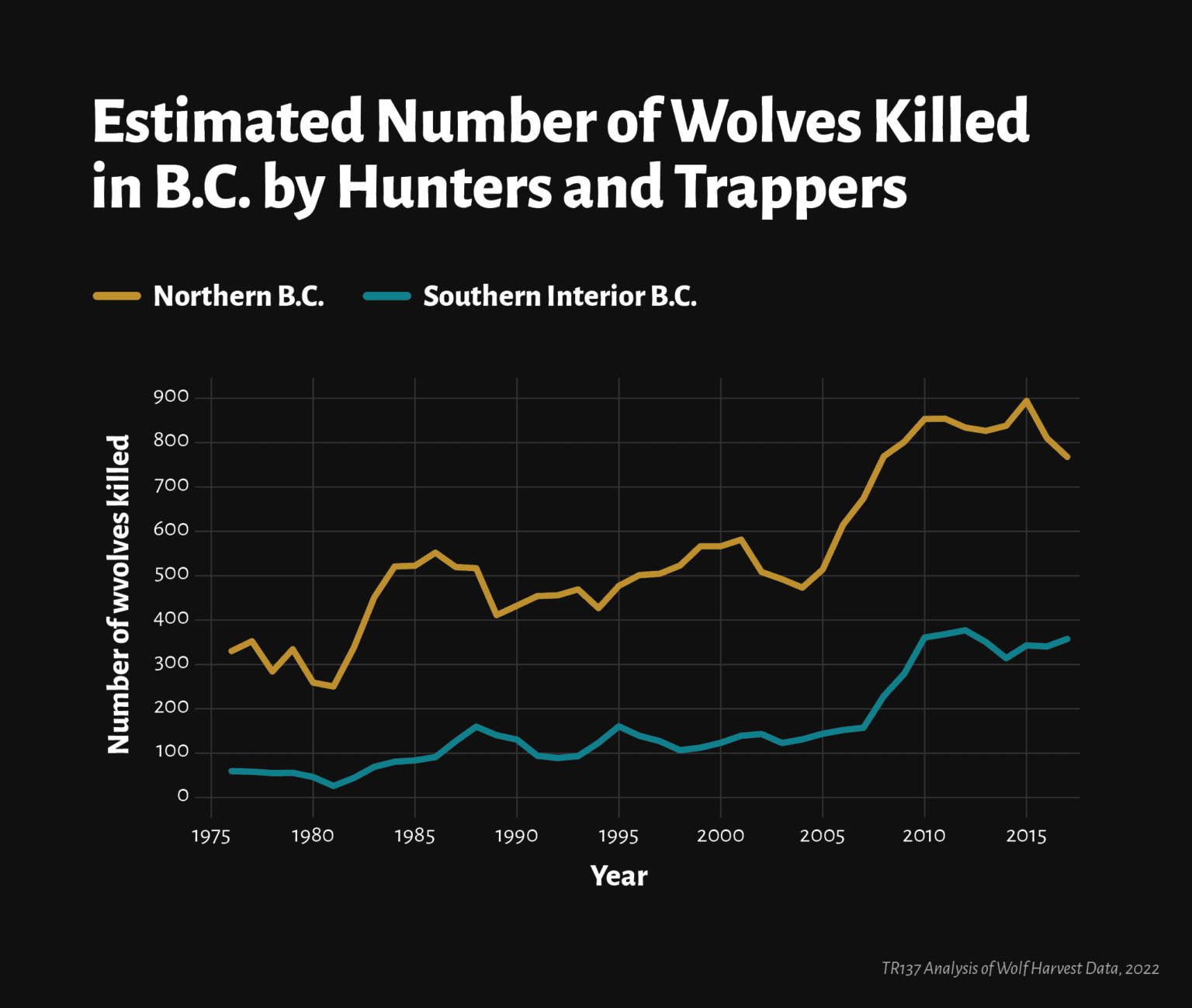A Voice for Wildlife,
A Call for Action
We are fortunate to live in one of the most biologically rich places on Earth. British Columbia is home to more species and ecosystems than any other province in Canada, including 70 per cent of the country’s freshwater species and 76 per cent of its bird species.1
The good news is that, unlike many parts of the planet, we still have a full complement of flora and fauna, from tiny flowering plants to the mighty apex predators that roam our forests and oceans. But the bad news is that over 1,600 species in B.C. are at risk.2 From songbirds to killer whales, from mountain caribou to plants that may soon disappear forever, many of these species face extinction unless we change course and find ways to better coexist with the natural world.
At Pacific Wild, we deeply understand this. Through our advocacy, both in the courts and in the court of public opinion, we are committed to protecting wildlife in Western Canada. One of our primary focuses remains the protection of wolves—magnificent, socially-evolved creatures that are being killed under government-sponsored programs.
We also continue to fight for the protection of the grizzly bear, maintaining the hard-fought ban on trophy hunting that we won years ago. Every year brings fresh attempts to reinstate this shameful hunt, and our fight to keep current protections intact is ongoing. A victory for wildlife is only as strong as its long-term stewardship.
In the oceans, we are making progress too. Our efforts to establish large, functioning marine protected areas are our best chance at bringing species back from the brink, but there is still much to do. We continue to document the damage caused by factory trawlers, with their wasteful bycatch of salmon, herring, sharks, marine mammals, and seabirds. This industry has operated with impunity for far too long, and Pacific Wild is committed to exposing its hidden impacts on our coast.
As we face these challenges, I am reminded of the words of naturalist and author John Muir, who said that in wild nature there is hope. At Pacific Wild, we believe this wholeheartedly. It is not just a statement, but a call to action. Every effort we make is focused on the protection of wildlife and the conservation of their critical habitats. While we take time to reflect on the successes we’ve been a part of, we are also constantly reminded of the new threats that arise and the work still left to do.
The future of our planet and all its creatures is not something we can take for granted. Thanks to the continued support of our incredible community, we remain on the front lines of wildlife conservation, working to protect the lands and waters that sustain us all—for today, and for generations to come.
Thank you for being part of this important work.


Karen McAllister, Executive Director
This Year, Pacific Wild:





Five Years Too Long for Wild Fish
Wild salmon continue to decline up and down the West Coast3 as their future is played out in the latest game of political football.
In 2019, the federal government announced that open-net pen salmon farms would be removed from B.C. waters by 2025. This year, the government backtracked and announced a further five-year window until open-net pen salmon farms must be removed by 2029. In late September, seven weeks late, they finally released a draft transition plan for salmon farms (of which Pacific Wild will be taking part in the consultations).

Wild salmon face existential threats from warming oceans, habitat destruction, and overfishing. Open-net salmon farms introduce diseases, parasites, and pollution to wild salmon populations. Waste and chemicals discharge into adjacent ecosystems. Farmed salmon can escape their pens, spreading disease and competing with wild salmon for food. We should be doing everything in our power to protect the lifeblood of our coastal ecosystem and economy. Putting the already critically low salmon population through another five years of threats from open-net salmon farms is unacceptable.
It’s Time to F*** off. Someone Had To Say It.
In June, when the federal minister of fisheries announced the decision to delay the removal of open-net salmon farms, Pacific Wild told the government exactly how most Canadians feel about the issue with none of our signature politeness. Our F*** off campaign, produced in collaboration with William Shatner and Maximum Effort, reached millions of viewers across the internet and through traditional media.
Collective voices are stronger than individual ones, and this campaign generated thousands of impolite and un-Canadian letters to the government. With your help, we will continue to speak out for the health of wild salmon.
75%
of B.C.ers polled support a transition away from open-net pen fish farms4
7M
campaign video views
120
First Nations support a transition away from open-net pen fish farms5
1,136
media stories about the campaign
Countdown to a Fish Farm-Free Future
Pacific Wild is tracking the impact of aquaculture on wild salmon, and here’s what we know has happened since the federal government postponed the removal of open-net farms to 2029:

june 2024
Concepcion Farm: Grieg Seafood reported sea lice levels over 10 times the allowable limit at their farm in Nootka Sound. That’s 10 times the disease vectors that can harm wild salmon!
August 2024
West Coast Fish Culture received a $350,000 fine for illegal practices at its Lois Lake site. Inspections revealed severe deficiencies, including improper pen installations and inadequate measures to prevent fish escapes.
September 2024
Cermaq began stocking its semi-closed containment farm with young Atlantic salmon. The system, previously shut down due to toxic ammonia levels that led to mass die-offs, could become a viral superspreader that compromises wild salmon health throughout Clayoquot Sound.
How many more salmon will we lose in the next five years? It’s time to hold the government accountable and demand the swift removal of open-net salmon farms in B.C.. The future of our wild salmon and the ecosystems they sustain depends on it.
Lost at Sea: Trawling’s Hidden Toll
Industrial trawling poses a severe threat to marine ecosystems, and Pacific Wild has been at the forefront of exposing its detrimental impacts in B.C. and beyond.
One of the most alarming issues of 2024 that we were able to bring to light was the staggering amount of salmon bycatch caught in the trawl fishery—both in B.C. and Alaska—discovered by the “enhanced monitoring” that was put into place by Fisheries and Oceans Canada (DFO).
In B.C., an estimated 28,117 salmon (93 per cent of which were Chinook) were caught, killed, and discarded as bycatch by the mid-water trawl fleet in a single fishing season.6 In response, DFO enforced in-season area closures around northern Vancouver Island. In the Gulf of Alaska, nearly 20,000 Chinook salmon were caught as bycatch in the pollock fishery, prompting the fishery to implement an early shut-down for the entire fleet. The Chinook eliminated by the midwater trawl fishery in B.C. alone could have fed three or four critically endangered Southern Resident killer whales for an entire year.

This year, Pacific Wild finally obtained access to a decade’s worth of bycatch data. Standard monitoring procedures revealed the startling numbers of target and non-target species caught and discarded by trawlers. What would enhanced monitoring reveal about the countless other species being destroyed by the B.C. trawl industry, such as herring, halibut, and rockfish?
Beyond bycatch, Pacific Wild teamed up with the University of Victoria’s Faculty of Law this year to gain a more comprehensive look at the legal aspects of industrial trawling. Pacific Wild has also embarked on a ground-breaking project to map the activities of industrial factory trawlers along the B.C. coast. We are using Automatic Identification System (AIS) technology to track the movement and fishing patterns of factory trawlers. This project will provide much-needed transparency about where trawlers operate, how frequently they fish in sensitive marine habitats such as Marine Protected Areas (MPAs), and the extent of their impact on various species.
Stay tuned in 2025 as we release the results of our research and continue to expose the full scope of industrial trawling’s impact on the ocean.
Herring 2024
Pacific Wild has long championed the protection of Pacific herring, a foundation species in B.C.’s coastal ecosystems. This year, we released “14 Arguments Against the Herring Fishery,” a damning report on how the commercial sac roe herring fishery threatens the survival of the species in B.C..
This fading fishery contributes minimally to the economy relative to the ecological damage it causes. Our comprehensive mapping of spawning grounds revealed how these sensitive areas are shrinking and require stronger protections. Additionally, our climate research showed how warming oceans and changing ecosystems are making herring populations even more fragile, amplifying the need to halt harmful commercial practices and allow herring to recover while there is still time.
Armed with these findings, Pacific Wild brought this critical issue to coastal communities, connecting with herring advocates and locals in the Salish Sea.
By building on our research and community engagement, we aim to galvanise further action to protect herring for future generations of marine life and coastal communities alike.
Killer Oil in Critical Habitat
The Trans Mountain oil pipeline that cost Canadian taxpayers over 30 billion dollars will come at a steep cost to our climate and environment — a cost that will only get worse over time. But it is the 72 endangered Southern Resident killer whales in the Salish Sea who will be immediately affected by it, as oil tankers enter and leave Lower Mainland seaports and travel through their critical habitat. These vessels are among the loudest in the world, and will have an enormous impact on these acoustically-sensitive whales who rely on their ability to emit and respond to sounds to communicate and feed themselves. These whales are already under terrible threat due to declining Chinook salmon stocks. But the increase in shipping noise could bring these magnificent whales to the point of no return.
And it isn’t just there that fossil fuel development is threatening our cetaceans. Farther north in the Great Bear Rainforest, the largest capital project in Canadian history is about to transform one of the most important whale sanctuaries in the North Pacific into a petro-highway of shipping noise and pollution. Years ago, the sales pitch for Canadian liquid natural gas (LNG) was that it would help transition Asian energy use from dirty coal to “natural” gas. Conveniently, the release of CO₂ and methane that LNG creates from fracking, liquefaction, and transportation was not included in estimating the overall greenhouse gas emissions that this project would produce. Even worse, recent accounting of total emissions shows that burning Canadian LNG in Asia will release 33 per cent more emissions than coal.7
This fading fishery contributes minimally to the economy relative to the ecological damage it causes. Our comprehensive mapping of spawning grounds revealed how these sensitive areas are shrinking and require stronger protections. Additionally, our climate research showed how warming oceans and changing ecosystems are making herring populations even more fragile, amplifying the need to halt harmful commercial practices and allow herring to recover while there is still time.
Armed with these findings, Pacific Wild brought this critical issue to coastal communities, connecting with herring advocates and locals in the Salish Sea.
By building on our research and community engagement, we aim to galvanise further action to protect herring for future generations of marine life and coastal communities alike.
Marine Milestones
The Coastal Marine Strategy and the Project Finance for Permanence (PFP) initiative for the Great Bear Sea mark two major conservation milestones in B.C. in 2024. The Coastal Marine Strategy is B.C.’s first comprehensive approach to protecting marine ecosystems, addressing issues of jurisdictional confusion and lack of cohesion, which have historically led to many delays for environmental protections. Co-created with Indigenous governments, this strategy focuses on conservation, climate resilience, and integrating local knowledge with science.
The PFP brought together 17 First Nations, the federal and provincial governments, and philanthropic partners to secure $335 million in funding to benefit coastal economies while protecting the Great Bear Sea. The PFP is expected to create 3,000 new jobs, provide 32,000 days of skills training for coastal communities, restore fish stocks, and contribute to global 30×30 conservation goals.
Together, the PFP and Coastal Marine Strategy represent a significant step towards meeting global conservation targets while empowering coastal communities. Thank you for continuing to support marine conservation.
Beautiful B.C. a Travesty for Travellers?
As of 2024, over 2,000 wolves have been killed in B.C. at a cost of over 11 million tax dollars. We are nearing the 10-year anniversary of the wolf cull, which the B.C. government introduced as a “short-term measure” in 2015. When will it end? A government-funded study published this year stated that “in the absence of habitat conservation and restoration, predator reductions would be required indefinitely to avoid the extirpation of southern mountain caribou.”8 Yet critical old-growth habitat is still being destroyed in these endangered herd regions even while government and conservationists alike agree that without it, caribou won’t survive.
2,192
Wolves culled since 2015
$11.5M
Spent since 2015
248
Wolves killed in 2024
34
Packs eliminated in 2024
33
Judas wolves collared in 2024
2
Caribou kills (by wolves) observed in 2024
A study released in 2021 showed little progress toward conserving caribou habitat in Alberta and B.C., with habitat loss actually increasing up to 262% eight years after the release of the federal recovery strategies.9 Oil and gas developments continue to fragment critical caribou habitat and logging continues unimpeded by the Ministry of Forests, which managed both timber sales and the Caribou Recovery Program until 2022. Seven herds of southern mountain caribou have become locally extinct in British Columbia, and yet caribou hunting is still allowed in many regions of the province through Limited Entry Hunt (LEH) draws. In 2024 the Province made 810 LEH tags available to hunters.
Our mapping research reveals that a jaw-dropping 136,000 square kilometres of caribou habitat have been lost due to human disturbance—that’s more than four times the size of Vancouver Island. Over the past decade, B.C. taxpayers have provided $365 million in subsidies per year to the logging industry.10 What this means is that, essentially, taxpayers are funding mass extinction.
With your help, Pacific Wild continues to push governments to do better for wildlife and challenge outdated attitudes that rank the value of one animal over another. Send a letter to the Province calling for real action to save caribou and stop the wolf cull.
By Saving Forests We Save Our Future
In March, Pacific Wild co-founder Ian McAllister made a heart-breaking discovery in the field. He learned that B.C Timber Sales (BCTS) was clearcutting ancient forests surrounding Cape Scott Provincial Park on Vancouver Island—a place with trees up to 1,000 years old.
For more than 20 years, BCTS has prioritised timber extraction at the expense of Indigenous rights, leadership, and stewardship. BCTS has compromised watersheds, biodiversity, wildlife habitats, and human sanctuaries. It has exacerbated risks from wildfires, droughts, and flooding. The situation is urgent, and yet the B.C. government has failed to implement the 14 critical recommendations of the Old Growth Strategic Review panel—measures essential for preserving the remaining old-growth and primary forests in the province.
These forests hold great value for the tourist industry and climate-crisis mitigation, but the B.C. government shows no signs of stopping the destruction of the province’s most precious ecosystems. In the lead-up to the provincial election, David Eby and John Rustad both proposed removing red tape to allow BCTS to harvest more timber with less oversight.11 How can the government expect corporations to make changes if they can’t implement the Old Growth Strategic Review recommendations within the BCTS, an agency under their direct control?
Every inch of protected land represents a passionate, hard-won victory. Together we can continue to protect these beautiful forests not just as places to visit, but as the source of the air we breathe, a bulwark against wildfires, and a buffer against the rising tide of climate change.
Killing Wolves Goes Beyond the Cull
This year, Pacific Wild discovered the war on wolves in B.C. goes beyond the wolf cull. Wolf hunting in B.C. has increased dramatically since the 2000s. In 2017, the Okanagan and Lower Mainland reopened hunting after a nearly 40-year closure. According to the B.C government’s Hunter Sample Survey Estimates, 6,559 wolves were killed by hunters and trappers between 2015 and 2023. 5,963 of these wolves were killed in regions where the wolf cull was also taking place.12 These numbers are likely a significant underestimate of the real slaughter.
According to a provincial government report, “the wolf hunting season is the most liberal of any large animal hunted in British Columbia.”13 Unlike other large predators such as cougars and bears, hunters do not need a species-specific licence or tag to hunt wolves. There is no limit to how many wolves may be killed per year in most of B.C., and the government does not require hunters to report their kills. The Province acquires estimates of the number of wolves hunted through random selection surveys of 20 per cent of hunters. These surveys are optional and only 40 per cent of those approached respond.13
In the 2014 provincial Grey Wolf Management Plan, the Province estimated the median population wolves in B.C. to be 8,500 animals.14 Since 2015, an estimated 8,751 wolves have been killed by hunters or through the wolf cull. According to the Ministry, this does not represent a “conservation concern.” 15
In the mid-sixties, B.C. wolves were extirpated in certain regions, like Vancouver Island and the Lower Mainland. They have since become more abundant again, but in our opinion, permitting a near-unbridled killing of wolves when population data is essentially non-existent is imprudent.
Notwithstanding population numbers, according to eminent wolf biologists John and Mary Theberge, “wolves are a small-society, social species… with similar mid-brain architecture and physiology to humans that underpin many emotions and drives. Wolves are also both an ecological umbrella and an ecological-dominant species with broad interdependencies and influences throughout their ecosystems.”
From this perspective, no amount of wolf persecution is acceptable, but it is especially reprehensible when disproportionately large kills are made in various regions, such as what is occurring as part of the government-approved aerial shooting of wolves.
A win for wolves!
For decades, wolves and many other species succumbed to painful poisonings each year, but in March 2024 Health Canada banned all uses of strychnine across the country.
Going for Gold: The Push for a Grizzly Bear Protection Act
In 2024, Alberta’s Forestry and Parks Minister, Todd Loewen, suddenly overturned the province’s 18-year grizzly bear hunting ban to allow a pool of hunters to shoot so-called “problem” bears.16 Without legislative protection, B.C’s 2017 ban on grizzly bear hunting could be reversed as easily as it was when the provincial Liberal Party replaced the NDP in 2001.

In the lead-up to B.C.’s provincial election, we screened the film for a sold-out audience in Victoria and shared it with over 300 people online who organised their own screenings. One of the most frequent pieces of feedback we received was, “I had no idea B.C. even had a grizzly bear hunt, let alone the work that went in to ban it!” We look forward to sparking new conversations as we bring the film to more communities in 2025. Contact us if you’re interested in hosting a screening!
Write to your elected representatives and join us in our push to create a Grizzly Bear Protection Act to safeguard this incredible animal for future generations.

Champions for Wildlife Corridors
This year, a grizzly nicknamed “Captain Hook” became the mascot for protecting wildlife corridors. When Michael Proctor began the Trans-Border Grizzly Bear Project in 2004, which later became Kootenay Connect, the South Selkirk grizzly population had shrunk to under 60 individuals and had been cut off from external populations by human developments for over 60 years. Consequently, land was purchased to establish a wildlife corridor connecting the Selkirk and Purcell Mountains through the Creston Valley. He collaborated with community members to secure garbage and install electric fencing around orchards and chickens. He also worked with the conservation officers to employ non-lethal management techniques on a select few bears in conflict situations. As of 2022, the South Selkirk population has welcomed 27 new cubs, born to nine migrant bears who mated with the local grizzlies. 13 of these cubs were fathered by avid wildlife corridor user Captain Hook.
“Grizzly bears are a keystone species. By protecting grizzly bears and their habitats, there’s all kinds of other species you’re protecting as well.”
— Wayne McCrory
Proctor’s study demonstrates the importance of being strategic about protecting wildlife habitat. Grizzly bears cannot survive in “islands of protection.” The provincial and federal governments have committed to protect 30 per cent of lands and waters by 2030 to safeguard biodiversity. Join Pacific Wild’s call for the government to keep their promises and protect lands strategically for wildlife: grizzlies are a transboundary species with wide habitat ranges and they need connected corridors of protected habitat to survive.
Last October, Pacific Wild interviewed renowned bear biologist Wayne McCrory in a B.C. Timber Sales cut block situated in the middle of a major international grizzly bear cross-valley corridor between the Goat and Kokanee ranges in the Kootenay region. There is more logging planned for the corridor, but McCrory has submitted a proposal to protect over 11 thousand hectares of it as a Wildlife Habitat Area (WHA). Wayne has named this proposed area “White Grizzly” in honour of a rare white-phase grizzly that roams that valley and nearby mountains.
Karsten Heuer (1968-2024) will be remembered for dedicating his decades to conservation, including leading the reintroduction of wild bison to Banff National Park. Karsten was known for marrying big conservation issues with big, human-powered adventures. In 1998-99, he hiked 3,400 km from Yellowstone to the Yukon to highlight the need for wildlife corridors. In 2002, he followed a herd of 150,000 caribou across part of the Yukon and Alaska to their calving grounds, which are threatened by oil development. People can donate in Karsten’s memory to Bow Valley Engage to help their #Savegrizzcorridor and Stop TSMV campaigns. For more info: bowvalleyengage.com
Doing Better for Bears in Our Communities
In 2023 alone, conservation officers killed 603 black bears, the highest number in a decade.17 A further 164 black bears were killed in the first six months of 2024. The numbers are appalling and the people of B.C. are ready for change. Many residents don’t report human-bear incidents at all, knowing that reporting all too often results in death sentences for bears and leaves cubs orphaned. At the urging of concerned residents (and Pacific Wild), some municipalities decided to take matters into their own hands.
In 2024, the District of North Vancouver became the first municipality to pass a resolution calling for an audit of the B.C. Conservation Officer Service (BCCOS) and the creation of an independent body to oversee the agency. The resolution gained support from other districts and was passed by the Lower Mainland Local Government Association last spring.
While the municipal resolution did not receive a final endorsement, the Province, in partnership with the Grizzly Bear Foundation, announced in early September that it would create an expert panel to recommend policies that will reduce conflicts between people and wildlife. The Province also now promised to implement third-party oversight and begin investigations into major complaints against the BCCOS.
Pacific Wild has long advocated for a change in how we coexist with wildlife in our communities. While we commend the government for recognizing the urgent need for an overhaul of the BCCOS, the proof of its commitment will be in whom it appoints to the panel and oversight committee, and in the recommendations it makes. Coexistence between humans and wildlife cannot be achieved at gunpoint.

Remembering Sheila Carnegie
Sheila Carnegie grew up on the prairies, but her love for travel and adventure spanned the world. A published author of short stories and lyrical poetry with a master’s degree in education, Sheila found solace walking the forests and beaches of her Denman Island home with her beloved dogs. Sheila also lived for several years in the Ecuadorian Andes, a place that remained close to her heart. Sheila had a soft spot for Pacific herring, and strongly supported Pacific Wild’s passion for environmental and wildlife sustainability. We have received her legacy contribution with immense gratitude, and are using her gift to help promote the causes she valued.
More Ways to Give to Wildlife
We at Pacific Wild are so grateful for all the support we receive from you. We couldn’t do the work we do without it. So we thought we’d remind you of the many ways you can use to continue to support our conservation work in addition to our online giving tools:
- Join the Wild Giving League monthly giving circle for a
bigger impact - Make a gift through a family fund
- Donate stocks or securities
- Donate a vehicle, boat, car, or motorcycle
- Donate as a for-profit business through Friends of Pacific Wild
- Offer your professional services pro-bono
- Ask your employer about matching donations for charities
like Pacific Wild - Remember us in your will
The Power of Legacy Giving
A gift for Pacific Wild’s conservation work creates a lasting legacy that aligns with your values and passion for B.C.’s wildlife and their habitat. Charitable donations in wills can provide tax benefits to your estate, potentially reducing the overall tax burden. You can even create a will through our partner, Epilogue Wills, with a Pacific Wild discount. Even modest legacy gifts can have a significant impact when combined with other donations and government funding, amplifying the overall effect on conservation efforts.

journal hard copy
We mail hard copies of the Pacific Wild Journal to our donors every fall.
Don’t miss out in 2025.
Credits
Written by: Ian McAllister, Karen McAllister, Kara Guloien, Laurie McConnell, Mollie Cameron, Natasha Wehn, Sydney Dixon
Edited By: Mariah Fleetham, Nick Read
Photographs by: Ian McAllister. Additional Photography by: Carlo Alcos, Charlene Edson, Brock Fenton, Dan Rafla, Jasper Sassaman, Lars Isaac, Lisa Stevens, Marine Coursac, Natasha Wehn, Sydney Dixon, Yvonne Gerard
References
- Bunnell, F.L., R.W. Campbell and K.A. Squires. 2004. “Allocating scarce resources for conservation in a species-rich environment: guidelines from history and science”. In. T.D. Hooper, ed., Proceedings of the Species at Risk 2004 Pathways to Recovery Conference. March 2-6, 2004, Victoria, B.C.
- Government of British Columbia. (n.d.). BC Species & Ecosystems Explorer. https://a100.gov.bc.ca/pub/eswp/search.do
- Connors, K., Jones, E., Peacock, S., and Belton, K. (2024). State of Salmon 2024 Report. Pacific Salmon Foundation, Vancouver, BC, Canada. DOI: 10.60740/3867-G827 https://stateofsalmon.ca/
- Kajani, S. (2021, July 27). Vast majority of British Columbians (86%) are concerned about declining wild salmon stocks (Insights West Poll, July 2021). Wild First. https://www.wildfirst.ca/vast-majority-of-british-columbians-86-are-concerned-about-declining-wild-salmon-stocks/
- First Nation Wild Salmon Alliance: Protecting Wild Pacific Salmon. FNWSA. (n.d.). https://www.firstnationwildsalmonalliance.ca/
- Lagasse, C.R., Fraser, K.A., Houtman, R., Grundmann, E., Komick, N., O’Brien, M., Braithwaite, E., Cornthwaite, A. M. 2024. Review of Salmon Bycatch in the Pacific Region 2022/23 Groundfish Trawl Fishery and Preliminary Results of an Enhanced Monitoring Program. Can. Manuscr. Rep. Fish. Aquat. Sci. 3273: v + 35 p.
- Howarth, R. W. (2024). The greenhouse gas footprint of liquefied natural gas (LNG) exported from the United States. Energy Science & Engineering. https://doi.org/10.1002/ese3.1934
- Lamb, Clayton T., Sara Williams, Stan Boutin, Michael Bridger, Deborah Cichowski, Kristina Cornhill, Craig DeMars, et al. (2024). “Effectiveness of Population-Based Recovery Actions for Threatened Southern Mountain Caribou.” Ecological Applications 34(4): e2965. https://doi.org/10.1002/eap.2965
- Nagy-Reis M, Dickie M, Calvert AM, et al. (2021). Habitat loss accelerates for the endangered woodland caribou in western Canada. Conservation Science and Practice. https://doi.org/10.1111/csp2.437
- Broadland, D. (2020, July 3). Forestry doesn’t pay the bills, folks. Focus on Victoria. Retrieved November 13, 2024, from https://www.focusonvictoria.ca/issue-analysis/35/
- Parfitt, B. (2024, October 23). Why both parties are wrong about BC’s forestry crisis. The Tyee. https://thetyee.ca/Analysis/2024/10/17/Both-Parties-Wrong-BC-Forestry-Crisis/
- B.C. Wildlife Management. (2023). Hunter Sample Survey Estimates 1976 to 2023. https://catalogue.data.gov.bc.ca/dataset/hunter-sample-survey-estimates-1976-to-current/resource/e3a8de8c-dbc8-498d-8a70-8f578ef548de
- Mowat, G., L. Vander Vennen, M. Anderson, M. Bridger, S. White, S. Marshall, K. MacAulay, and S. O’Donovan. (2022). An Evaluation of the Accuracy of Licensed Wolf Harvest Data and the Correlation with Population Trends in British Columbia. Prov. B.C., Victoria, B.C. Tech. Rep. 137. https://www.researchgate.net/publication/359930228_An_Evaluation_of_the_Accuracy_of_Licensed_Wolf_Harvest_Data_and_the_Correlation_with_Population_Trends_in_British_Columbia
- B.C. Ministry of Forests, Lands and Natural Resource Operations. (2014). Management Plan for the Grey Wolf (Canis lupus) in British Columbia. https://www.env.gov.bc.ca/fw/wildlife/management-issues/docs/grey_wolf_management_plan.pdf
- Provincial Caribou Recovery Program, email communication, Jun 13, 2024.
- Pike, Helen, and Joel Dryden. (2024). Certain ‘problem’ grizzly bears can now be hunted in Alberta. CBC News. https://www.cbc.ca/news/canada/calgary/alberta-todd-loewen-grizzly-bears-fish-and-wildlife-1.7258821
- Ministry of Environment and Climate Change Strategy. (2024, October 31). Predator statistics: Black Bear. Province of British Columbia. https://www2.gov.bc.ca/gov/content/environment/plants-animals-ecosystems/wildlife/human-wildlife-conflict/predator-statistics-black-bear



